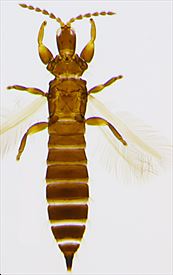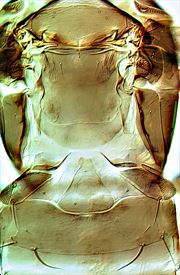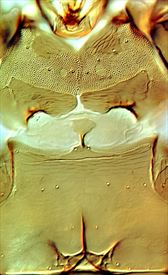Distinguishing features
Both sexes fully winged. Female brown; antennal segment I paler, III yellow on basal half; all femora variably yellow at apex, but tibiae and tarsi brown; fore wings shaded; major setae brown. Head longer than wide; eyes large, hind ocelli abutting compound eye margin; postocular setae shorter than eye width, bluntly acute; maxillary stylets retracted to postocular setae, with prominent arched maxillary bridge. Antennae 8-segmented; 3 sense cones on segment III, 4 on segment IV; segment VIII broad at base. Pronotum without sculpture, major setae pointed; epimeral sutures incomplete, posteroangular setae arising close to epimeral setae; basantra present but variably eroded. Mesopresternum variably reduced, slender, partly fused to mesoeusternum. Metanotum with no sculpture medially; metathoracic sternopleural sutures exceptionally wide at anterior, tapering towards posterior. Fore and hind femora larger than middle femora, fore tarsus with small recurved tooth at inner apex. Fore wings parallel-sided, with 7–11 duplicated cilia; sub-basal setae long, finely acute, their bases arranged in a triangle. Pelta elongate, recessed into concave anterior margin of tergite II; tergite II lateral margins eroded; tergites II–VII each with one pair of large sigmoid wing-retaining setae; tergite IX posteromarginal setae S1 acute, as long as tube, S2 longer; tube with anal setae scarcely as long as basal width of tube.
Male similar to female, tergite IX posteromarginal seta S2 longer than S1; sternite VIII with a broad, transverse pore plate.
Related species
Only one species is described in the genus Yarnkothrips. Despite the well developed maxillary bridge, this species is probably not a member of the Haplothripini, in view of the small basantra, parallel-sided fore wings, broad metathoracic sternopleural sutures, short anal setae, long S2 setae on tergite IX in the male, and the presence of a large pore plate.
Biological data
Collected originally from yellow lichen on twigs, this species has subsequently been taken from dead branches of many different tree species, but always in low numbers. In view of the structure of the fore legs, it is possible that Y. kolourus is a predator of some other small arthropods.
Distribution data
Apparently widespread but uncommon in southeastern Australia, including Tasmania, and also seen from New Caledonia and Norfolk Island (Mound & Wells, 2015), this species was first described from New Zealand (AK / SD, MB, CO).
Family name
PHLAEOTHRIPIDAE, PHLAEOTHRIPINAE
Species name
Yarnkothrips kolourus Mound & Walker
Original name and synonyms
Yarnkothrips kolourus Mound & Walker, 1986: 83
References
Mound LA & Walker AK (1986) Tubulifera (Insecta: Thysanoptera). Fauna of New Zealand 10: 1–140.
Mound LA & Wells A (2015) Endemics and adventives: Thysanoptera (Insecta) Biodiversity of Norfolk, a tiny Pacific Island. Zootaxa 3964 (2): 183–210.




